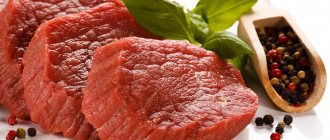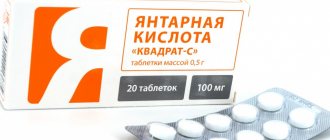Pharmacological properties of the drug Ursodeoxycholic acid
Synthetic stereoisomer of chenoxycholic acid. It has a membrane-stabilizing and hepatoprotective effect, protecting hepatocytes from damaging factors. It has immunomodulatory activity and reduces the severity of immunopathological reactions in the liver. By stimulating exocytosis in hepatocytes during cholestasis by activating Ca2+-dependent α-protein kinase, ursodeoxycholic acid reduces the concentration of bile acids that are toxic to hepatocytes (cholic, lithocholic, deoxycholic, etc.). Inhibits the absorption of lipophilic bile acids in the intestine (apparently due to a competitive mechanism), increases their “fractional turnover” during the hepatic-intestinal circulation; induces choleresis with a high content of bicarbonates, which leads to an increase in the passage of bile and stimulates the excretion of toxic bile acids through the intestines. By replacing non-polar bile acids, it forms non-toxic mixed micelles. By reducing the synthesis of cholesterol in the liver, as well as its absorption in the intestine, ursodeoxycholic acid reduces the lithogenicity of bile, reduces the cholate-cholesterol index, promotes the dissolution of cholesterol stones and prevents the formation of new ones. Ursodeoxycholic acid is absorbed in the small intestine by passive diffusion and in the ileum by active transport. When taken orally at a dose of 0.5 g, the maximum concentration in blood plasma after 30, 60 and 90 minutes is 3.8, 5.5 and 3.7 mmol/l, respectively. When taken systematically, ursodeoxycholic acid becomes the main bile acid in the blood serum, accounting for about 48% of the total pool of bile acids in the blood. Binding to blood plasma proteins is 96–99%. The therapeutic effect depends mainly on the concentration of ursodeoxycholic acid in bile and not in serum. The concentration of ursodeoxycholic acid in bile depends on the dose: as the daily dose increases, the content of ursodeoxycholic acid in bile increases accordingly. The maximum concentration of ursodeoxycholic acid in bile is observed when it is taken at a daily dose of 10–14 mg/kg. With a further increase in dose, the concentration of ursodeoxycholic acid in bile does not increase (plateau phase). About 50–70% of the administered dose is excreted in bile. Ursodeoxycholic acid penetrates the placental barrier.
Ursodeoxycholic acid
Ursodeoxycholic acid
(
UDCA
, English
ursodiol
or
ursodeoxycholic acid
) is a bile acid, one of the so-called
tertiary acids
, formed from primary bile acids in the colon under the influence of intestinal microflora.
May be called ursodeoxycholic acid.
Chemical name: (3-alpha, 5-beta, 7-beta)-3,7-dihydroxycholan-24-oic acid. Empirical formula: C24H40O4.
Ursodeoxycholic acid is a pharmaceutical agent (ATC code A05AA02) for the treatment of diseases of the gallbladder, liver, as well as gastritis and esophagitis caused or aggravated by bile reflux. Helps dissolve gallstones.
Mechanisms of action of ursodeoxycholic acid (Gubergrits N.B. et al.)
The main effects of ursodeoxycholic acid on cholesterol metabolism
- decreased secretion of cholesterol into bile
- reducing intestinal absorption of cholesterol and stimulating the release of cholesterol from stones into bile
- inhibition of the most important enzyme for cholesterol synthesis in the liver - HMC-CoA reductase.
Replacement of toxic bile acids
In order of increasing hydrophobic properties, bile acids are arranged in the following order: ursodeoxycholic > chenodeoxycholic > deoxycholic > lithocholic.
This order determines the increase in the toxicity of bile acids, since it is the hydrophobic properties that ensure the penetration of bile acids into lipid layers, primarily into membranes, both plasma and mitochondrial membranes, which causes a change in their functioning and ultimately cell death. Ursodeoxycholic acid competes with toxic bile acids during absorption in the small intestine and on the hepatocyte membrane. Ursodeoxycholic acid makes up no more than 5% of the total pool of bile acids. When taking medications containing ursodeoxycholic acid, its share in the total pool of bile acids increases to 60%. This leads to a decrease in the absorption of toxic bile acids and their entry into the liver, which explains the cytoprotective properties of ursodeoxycholic acid. These same effects are also achieved by other mechanisms. In particular, ursodeoxycholic acid is able to integrate into the cell membrane, which becomes more resistant to the damaging effects of toxic bile acids and ethanol metabolic products.
Ursodeoxycholic acid also prevents other effects of toxic bile acids: mitochondrial dysfunction, release of cytochrome C from membranes into the cell cytosol with the subsequent development of apoptosis, disruption of cellular ion homeostasis and cell death through necrosis.
The immunomodulatory properties of ursodeoxycholic acid are also associated with the replacement of toxic bile acids. The accumulation of toxic bile acids during cholestasis induces the expression of class I and II major histocompatibility complex molecules on the membranes of hepatocytes and cholangiocytes, which promotes their recognition with subsequent destruction by cytotoxic T lymphocytes. By reducing the amount of toxic bile acids, ursodeoxycholic acid leads to the suppression of this process (Nadinskaya M.Yu.).
Ursodeoxycholic acid is a drug for the treatment of reflux gastritis and esophagitis caused by bile acid reflux
The use of ursodeoxycholic acid to correct alkaline reflux is fundamentally new and one of the most effective methods of therapy.
Under the influence of ursodeoxycholic acid, the bile acids contained in the refluxate are converted into a water-soluble form, which is less irritating to the mucous membrane of the stomach and esophagus. Ursodeoxycholic acid has the property of changing the pool of bile acids from toxic to non-toxic. When treated with ursodeoxycholic acid, in most cases, symptoms such as bitter belching, abdominal discomfort, and vomiting of bile disappear or become less intense. Research in recent years has shown that for bile reflux, the optimal dose should be 500 mg per day, divided into 2 doses (Chernyavsky V.V.). The basis for the use of ursodeoxycholic acid for gastritis and esophagitis caused by duodengastroesophageal reflux is its cytoprotective effect. Displacement of the pool of hydrophobic bile acids and, probably, prevention of the apoptosis of epithelial cells induced by them lead to a decrease in clinical symptoms and endoscopic signs of damage to the mucous membrane of the stomach and esophagus (Bueverov A.O., Lapina T.L.).
In case of reflux esophagitis caused by reflux of duodenal contents (primarily bile acids) into the esophagus, which is usually observed in gallstone disease, a good effect is achieved by taking ursodeoxycholic bile acid at a dose of 5 mg/kg per day for 6-8 months ( Kalinin A.V.).
The use of ursodeoxycholic acid to dissolve stones and sediment in the gallbladder
Ursodeoxycholic acid is used in the treatment of gallstone disease.
It blocks enzymes that stimulate cholesterol synthesis, reduce its absorption in the intestines, and prevent sedimentation, shifting the balance of bile acids - cholesterol towards bile acids, which helps dissolve already formed small stones (up to 5 mm). Ursodeoxycholic acid is prescribed as an adjunct to shock wave crushing of cholesterol stones or to surgical treatment. Ursodeoxycholic acid, compared to other bile acids, is much more hydrophilic. Its higher polarity correlates with a lower tendency to form micelles. Ursodeoxycholic acid becomes the main component of bile, its lithogenic properties decrease, the sediment in the gallbladder dissolves, and the phenomena of cholestasis disappear. Ursodeoxycholic acid is prescribed for a long course (from six months to a year) at the rate of 10–15 mg per kg of patient weight per day. A third of the daily dose is taken orally in the morning on an empty stomach half an hour before meals and the remaining two-thirds before bedtime. Children under 3 years old take the suspension, from 4 years old and older take capsules coated with a special shell.
To dissolve gallstones, the ability of ursodeoxycholic acid to suppress the reabsorption of hepatotoxic endogenous bile acids in the small intestine is used, replacing them with non-toxic ursodeoxycholic acid. In addition, ursodeoxycholic acid reduces the cytotoxic effect of aggressive lipophilic bile acids, reduces the saturation of bile with cholesterol, and increases the solubility of cholesterol in bile through the formation of crystals with it. The dose of the drug for the treatment of cholelithiasis is approximately 10 mg per kg of the patient’s body weight per day. The duration of therapy is from one to two years or more (Kharitonova L.A.).
Ursodeoxycholic acid in the treatment of liver and biliary tract diseases
Ursodeoxycholic acid is used in the treatment of chronic hepatitis, including atypical forms of chronic autoimmune hepatitis, acute viral hepatitis, non-alcoholic steatohepatitis, alcoholic, drug and other toxic liver damage, primary biliary cirrhosis and cystic fibrosis of the liver, primary sclerosing cholangitis, atresia of the intrahepatic biliary tract, cholestasis with parenteral nutrition, biliary dyskinesia, chronic opisthorchiasis, prevention of liver damage when using hormonal contraceptives and cytostatics.
Materials for healthcare professionals regarding treatment of the digestive system with ursodeoxycholic acid
Articles and abstracts
- Chernyavsky V.V. Acid and alkaline gastroesophageal reflux: clinical significance and approaches to correction // News of medicine and pharmacy. Gastroenterology (thematic issue). – 2008. – 239.
- Ryzhkova O.V. Clinical and pathogenetic features, prevalence and treatment of cholelithiasis among workers in the oil industry of Tatarstan from the perspective of a systems approach. Abstract of dissertation. Doctor of Medical Sciences, 14.00.05 - ext. diseases. KSMA, Kazan, 2007.
- Nazarov N.S. Erosive reflux esophagitis in patients after gastrectomy or gastrectomy. Abstract of dissertation. Ph.D., 01/14/04 – ext. diseases. UMTS UDPRF, Moscow, 2015.
- Paliy I. G., Zaika S.V., Kavka S.A. Infusion of ursodeoxycholic acid therapy for acid and gastroesophageal reflux in patients with biliary pathology // Ukr. honey. Clock writer. – 2008. – 4 (66). – VII/VIII.
- Maev I.V., Gulenchenko Yu.S., Andreev D.N., Kazyulin A.N., Dicheva D.T. Duodenogastroesophageal reflux: clinical significance and approaches to therapy // CONSIUUM MEDICUM. 2014. VOL. 16. No. 8. pp. 5–8.
- Gubergrits N.B., Lukashevich G.M., Fomenko P.G., Belyaeva N.V. Bile reflux: modern theory and practice. DNMU named after. M. Gorky. – Moscow // M.: Forte print. 2014. 36 p.
- Lishchuk N.B., Simanenkov V.I., Tikhonov S.V. Differentiated therapy of “non-acidic” forms of gastroesophageal reflux disease // Therapeutic archive. 2021. No. 04. pp. 57-63.
- Lapina T.L., Kartavenko I.M., Ivashkin V.T. Pathogenetic and therapeutic significance of bile acids in reflux gastritis // RZHGGK. 2015. No. 1. pp. 86–93.
- Bondareva K.A., Shuleshova A.G., Danilov D.V. Features of treatment of erosive esophagitis in patients with coronary heart disease. Kremlin medicine. Clinical Bulletin. 2019; 2: 39-46.
On the website GastroScan.ru in the literature catalog there is a section “Gastroprotectors, cytoprotectors, hepatoprotectors”, containing articles concerning the treatment of the gastrointestinal tract with ursodeoxycholic acid preparations.
Video for doctors
Maslovsky L.V. Reflux esophagitis in patients with gastrectomy or gastrectomy
Embutnieks Yu.V. Management of patients with biliary reflux gastritis and esophagitis
Minushkin O.N., Zverkov I.V., Skibina Yu.S., Inevatova V.S. Chronic biliary reflux gastritis: presentation, pathogenesis, treatment
Gubergrits N.B.
Melody of digestion On the website GastroScan.ru in the “Video” section there is a subsection “For doctors”, containing video recordings of reports, lectures, webinars in various areas of gastroenterology for healthcare professionals.
Side effects of ursodeoxycholic acid
From the digestive system: diarrhea, nausea, pain in the epigastric region and right hypochondrium, calcification of gallstones, increased activity of liver transaminases.
When treating primary biliary cirrhosis, transient decompensation of liver cirrhosis may occur, which disappears after discontinuation of ursodeoxycholic acid. Other: allergic reactions.
Contraindications to the use of ursodeoxycholic acid
- X-ray positive, high calcium gallstones
- non-functioning gallbladder
- acute inflammatory diseases of the gallbladder, bile ducts and intestines
- liver cirrhosis in the stage of decompensation
- severe impairment of kidney, liver or pancreas function
- hypersensitivity to the components of the drug
- pregnancy or breastfeeding
Pharmacokinetics of ursodeoxycholic acid
Ursodeoxycholic acid is a hepatoprotective agent that has a choleretic effect. Ursodeoxycholic acid reduces cholesterol synthesis in the liver, its absorption in the intestines and concentration in bile, increases the solubility of cholesterol in the biliary system, and stimulates the formation and secretion of bile. Ursodeoxycholic acid reduces the lithogenicity of bile and increases the content of bile acids in it; causes increased gastric and pancreatic secretion, enhances lipase activity, and has a hypoglycemic effect. Causes partial or complete dissolution of cholesterol stones when administered enterally, reduces the saturation of bile with cholesterol, which promotes the mobilization of cholesterol from gallstones. Ursodeoxycholic acid has an immunomodulatory effect, affects immunological reactions in the liver: it reduces the expression of certain antigens on the hepatocyte membrane; affects the number of T-lymphocytes, the formation of interleukin 2, reduces the number of eosinophils.
Interaction of ursodeoxycholic acid with other drugs
Antacids containing aluminum hydroxide or smectite, cholestyramine, colestipol reduce the absorption of ursodeoxycholic acid in the intestine, reducing its effectiveness. Therefore, the listed medications must be taken at least two hours before taking ursodeoxycholic acid medications. Ursodeoxycholic acid may enhance the absorption of cyclosporine from the intestine. Therefore, when taking these drugs together, your doctor may need to adjust the dose of cyclosporine based on tests. Rarely, ursodeoxycholic acid may reduce the absorption of ciprofloxacin. Lipid-lowering drugs (especially clofibrate), estrogens, neomycin or progestins increase the saturation of bile with cholesterol and may reduce the ability of ursodeoxycholic acid to dissolve cholesterol formations.
Use of ursodeoxycholic acid by pregnant and nursing mothers
Ursodeoxycholic acid has an FDA Fetal Risk Category B when used by pregnant women. Breastfeeding women should only take ursodeoxycholic acid under medical supervision.
Trade names of drugs with the active substance ursodeoxycholic acid
The following drugs with the active substance ursodeoxycholic acid (ursodeoxycholic acid) are registered (have been registered) in Russia: Grinterol, Livodexa, Urdoxa, Urso 100, Ursodez, Ursodex, Uroliv, Ursor Rompharm, Ursor C, Ursodeoxycholic acid, Ursosan, Ursofalk, Choludexan, Exhol .
Ukrainian production: ursodeoxycholic acid drug Ukrliv.
Some instructions from manufacturers on the use of drugs containing the only active ingredient ursodeoxycholic acid for patients in the UK (pdf, in English):
- "Ursofalk Patient Information Leaflet", Dr Falk Pharma GmbH, November 21, 2012.
- "Package Leaflet: Information for the User. Ursogal ® Tablets 150 mg (Ursodeoxycholic acid)", Almac Pharma Services Limited, December 2011.
- "Package Leaflet: Information for the User. Ursogal ® Capsules 250 mg (Ursodeoxycholic acid),” Almac Pharma Services Limited, June 11, 2010.
By Order of the Government of the Russian Federation of December 30, 2009 No. 2135-r, ursodeoxycholic acid (capsules, oral suspension) is included in the List of vital and essential medicines.
Ursodeoxycholic acid has contraindications, side effects and application features; consultation with a specialist is necessary.
Back to section
Indications for use of the drug Ursodeoxycholic acid
Primary biliary cirrhosis of the liver, primary sclerosing cholangitis, chronic active hepatitis, cystic fibrosis, atresia of the intrahepatic bile ducts, cholestasis with parenteral nutrition, alcoholic liver damage, acute hepatitis, prevention of liver damage when using hormonal contraceptives, treatment with cytostatics (during transplantation); cholesterol gallstones in the gallbladder (if it is impossible to remove them surgically or endoscopically), biliary reflux gastritis and reflux esophagitis, bile duct dyskinesia.
Use of the drug Ursodeoxycholic acid
For the treatment of patients with acute and chronic liver diseases and for the dissolution of cholesterol stones, a dose of 10 mg/kg per day is used continuously for a long time. In patients with chronic liver diseases, the duration of treatment can range from several months to 2 years. The duration of the process of dissolving gallstones when using urosodeoxycholic acid ranges from 6 months to 2 years. If after 12 months from the start of use there is no dissolution of gallstones, then treatment should be discontinued. Take daily in a daily dose once before bedtime.
Special instructions for the use of the drug Ursodeoxycholic acid
Successful conservative treatment of cholelithiasis is possible in the presence of purely cholesterol (X-ray negative) stones with a diameter of no more than 1.5–2 cm, preserved gallbladder function, patency of the cystic and common bile duct; stones should not fill more than half the volume of the gallbladder. To accurately determine the nature of the stones, it is recommended to perform radiography in combination with ultrasound. To prevent recurrence of cholelithiasis, treatment must be continued for several months after stone lysis. During treatment, transaminase levels should be dynamically monitored at least once a month; if their activity is increased, it is recommended to reduce the dose. Treatment should be discontinued if values do not return to normal within 1 month.
Deoxycholic acid
Deoxycholic acid
(eng.
deoxycholic acid
, or
deoxycholate
, or
cholanoic acid
, or
3α,12α-dihydroxy-5β-cholan-24-oic acid
) - bile acid, belonging to the so-called
secondary acids
, formed from primary bile acids in the colon under the influence intestinal microflora. The gross formula is C24H40O4. Molecular weight 392.57 g/mol. Deoxycholic acid will dissolve in alcohol and acetic acid. In its pure form it appears as a white or off-white crystalline powder.
Deoxycholic acid in the enterohepatic circulation of bile acids
Deoxycholic acid is formed from a conjugate of the primary bile acid - cholic, which enters the intestines of healthy people from the gallbladder, under the influence of anaerobic bacteria of the colon, where it is deconjugated by microbial choleglycine hydrolase and dehydroxylated with the participation of 7-alpha dehydroxylase.
The resulting deoxycholic acid binds to dietary fiber and is excreted from the body. Acidity in the intestinal lumen is of great importance. When the pH value increases, deoxycholic acid is ionized and well absorbed in the colon, and when it decreases, it is excreted. An increase in pH values in the colon leads to an increase in the activity of enzymes leading to the synthesis of deoxycholic acid, its solubility and absorption and, as a result, an increase in the level of bile acids, cholesterol and triglycerides in the blood. One of the reasons for the increase in pH may be the lack of prebiotic components in the diet, which disrupt the growth of normal microflora, including bifidobacteria and lactobacilli (Lyalyukova E.A., Livzan M.A.). Part of the total volume of deoxycholic acid absorbed in the intestine returns through the portal vein with the blood to the liver (this process is called enterohepatic circulation of bile acids). In hepatocytes, deoxycholic acid is conjugated, binds with glycine or taurine, turning into glycodeoxycholic or taurodeoxycholic acid, and circulates further in the human body along with primary bile acids.
The damaging effect of deoxycholic acid on the mucous membrane
It is assumed that deoxycholic and other bile acids can penetrate the cells of the mucous membrane, being in a non-ionized lipophilic form, thereby causing a damaging effect.
This process is acid-dependent and more pronounced at acidic pH values. When studying the composition of duodenogastroesophageal reflux in patients with erosive esophagitis and Barrett's esophagus, it turned out that with a predominance of cholic, taurocholic and glycocholic acids, there was a significant amount of deoxycholic and taurodeoxycholic acid. In terms of toxicity (and hydrophobic properties), deoxycholic acid is superior to cholic, ursodeoxycholic and chenodeoxycholic acids, but inferior to lithocholic acid.
To reduce the damaging effects of deoxycholic acid on the mucous membrane of the stomach and esophagus, ursodeoxycholic acid preparations are prescribed. Ursodeoxycholic acid is a competitive inhibitor of deoxycholic and other bile acids at all levels of their physiological action: molecular, cellular, tissue and systemic. Due to the significant displacement of hydrophobic deoxycholic and other bile acids from the enterohepatic circulation, ursodeoxycholic acid reduces their potential toxicity to hepatocytes, the epithelium of bile canaliculi, the mucous membrane of the esophagus and stomach, increases the fluidity and reduces the lithogenicity of bile.
Deoxycholic acid as a non-surgical treatment for double chin
At the end of April 2015, the FDA registered the injectable prescription (Rx) drug Kybella, working name ATX-101, developed by Kythera Biopharmaceuticals (USA), the active ingredient of which is synthetic deoxycholic acid. Kybella is approved for use in adult patients to improve the appearance of moderate to severe thickening or enlargement of the submental fat layer. Deoxycholic acid destroys the cell membranes of the fatty tissue under the chin without affecting the surrounding tissue.
| Kybella (deoxycholic acid) injection sites |
During each treatment session, the patient receives several injections of Kybella.
The session is carried out on an outpatient basis. Session duration is 15-20 minutes. The full course of treatment is 2-4, sometimes up to 6 sessions. Sessions are not held more often. than once a month. In 2021, deoxycholic acid, as an international nonproprietary name, is included in ATX, in “Section D. Drugs for the treatment of skin diseases”, in the group “D11A Other drugs for the treatment of skin diseases” and is assigned the code D11AX24.
On the website GastroScan.ru in the “Literature” section there is a subsection “Diseases of the hepatopancreatobiliary system”, containing publications for healthcare professionals on this topic.
general information
Deoxycholic acid is contained as an excipient in the hepatoprotective drug Essentiale N.
Deoxycholic acid has contraindications, side effects and application features; consultation with a specialist is necessary.
Back to section





